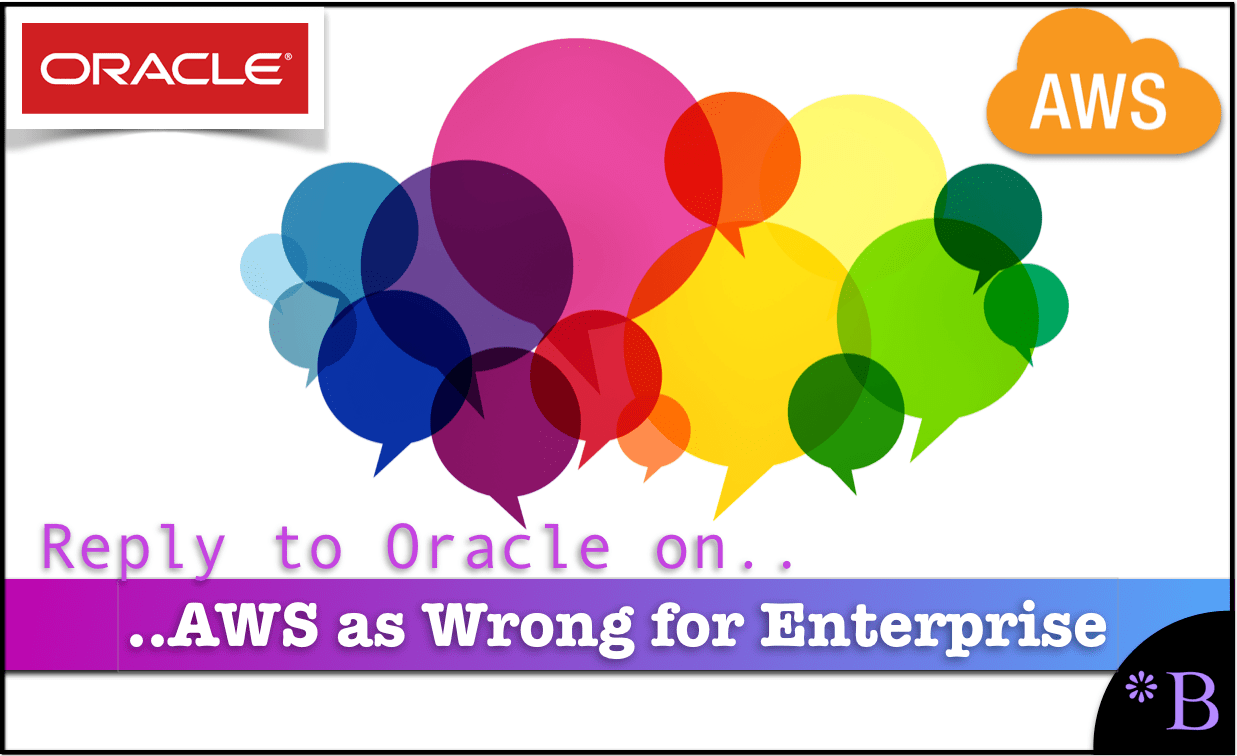How to Respond to Oracle’s Arguments that AWS is Inappropriate for Enterprise Workloads?
Executive Summary
- Oracle makes the argument that AWS is inappropriate for enterprise workloads.
- How valid is this argument against the cloud from Oracle?

Introduction
This article covers Oracle’s argument on AWS being wrong for “the enterprise.”
Our References for This Article
If you want to see our references for this article and other related Brightwork articles, see this link.
Lack of Financial Bias Notice: The vast majority of content available on the Internet about Oracle is marketing fiddle-faddle published by Oracle, Oracle partners, or media entities paid by Oracle to run their marketing on the media website. Each one of these entities tries to hide its financial bias from readers. The article below is very different.
- This is published by a research entity, not some dishonest entity that is part of the Oracle ecosystem.
- Second, no one paid for this article to be written, and it is not pretending to inform you while being rigged to sell you software or consulting services. Unlike nearly every other article you will find from Google on this topic, it has had no input from any company's marketing or sales department. As you are reading this article, consider how rare this is. The vast majority of information on the Internet on Oracle is provided by Oracle, which is filled with false claims and sleazy consulting companies and SAP consultants who will tell any lie for personal benefit. Furthermore, Oracle pays off all IT analysts -- who have the same concern for accuracy as Oracle. Not one of these entities will disclose their pro-Oracle financial bias to their readers.
See the following quote.
One common criticism of AWS by Oracle is that AWS is not appropriate for enterprise workloads. This is the official story on whether the largest database vendors have been moving to the cloud. Let us review the following quotation.
“Customers with the largest Databases in the world have or in process of moving to Oracle Cloud. For example AT&T is moving 1000’s of Databases that are all in the TB of size. Several petabyte in total. They are largest Telecom in the world and I believe are in top 3 of having largest databases in world. CERN, the European Organization for Nuclear Research, is one of the world’s largest and most respected centers for scientific research, in running quite a bit of services & Databases in Oracle Cloud. They I believe are in top 5 largest Databases in world. Sprint also a huge Oracle and Oracle Cloud customer. They’re also in top 5 largest Databases.. Generali, Unilever, and thousands of very large companies are migrating and/or running in Oracle Cloud. Here’s the ones that have been documented.
And by the way, you do know that Amazon runs Oracle Database (they pay Oracle ~$60M a year) just like many of the born in the cloud companies like SalesForce, SuccessFactors, Concur, Ariba, etc. And majority of largest Databases in the world are Oracle Databases including #1, World Data Center for Climate (WDCC).”
While this has some truthful examples, this is an extension of a common argument presented by Oracle. No matter what the application, only Oracle can run “enterprise workloads.” We have observed its usage so many times that we refer to it as the “Gatorade Argument.” The Gatorade Argument is where some niche capability (in this case, electrolyte drinks), which are only necessary for extreme endurance activities, is so they do not engage in such activities. In the past, Oracle made this argument against other database vendors, now they have adopted this argument against AWS, even AWS runs Oracle!
The Largest Customers Represent All Customers?
Oracle frequently talks about “Customers with the largest Databases in the world.” We congratulate Oracle for having these types of use cases, but these upper end case studies, as repeatedly pointed out by one of this book’s authors Ahmed Azmi comprise roughly 2% of the market. The World Data Center for Climate’s online database is designed to grow by 1 petabyte per year. What is the relevance of that database size to the vast majority of customers? Should the typical customer use what the World Data Center for Climate uses? Furthermore, Oracle seems to readily overlook many huge installations that don’t run Oracle. Do you know who does not run Oracle? Google. Google not only does not run the Oracle database, but they also moved away from Oracle’s MySQL in 2013. Google is also, like the World Data Center for Climate, one of the ten largest databases in the world. Oh, and MariaDB is open source, so see the price comparison at the beginning of this book to see how much money Google is saving (not that they even need to save money).
The Largest Versus Mainstream Customers
The mainstream doesn’t run the world’s largest databases, and they don’t need scorching fast HPC database performance. Speeds and feeds are never a priority for mainstream customers.